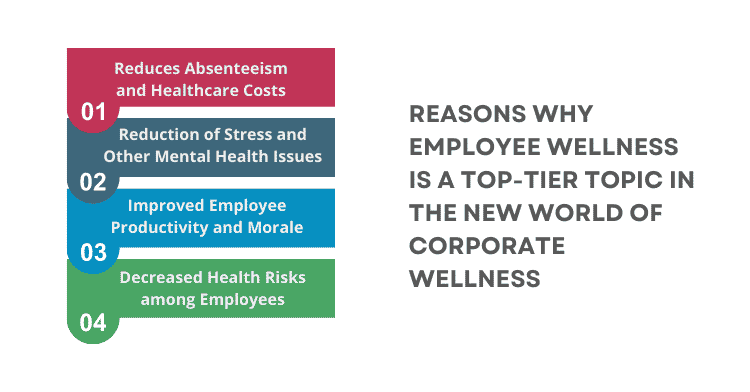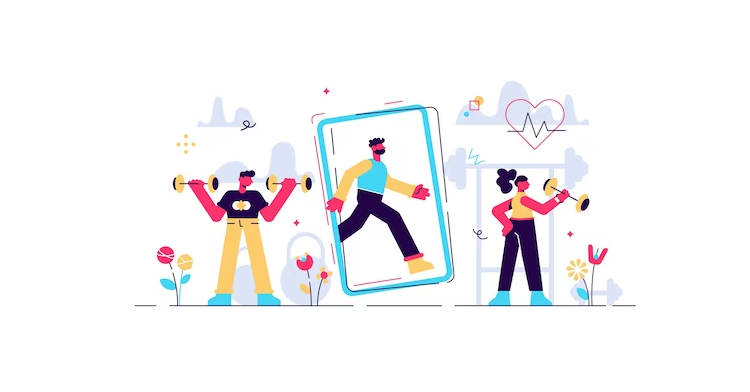In the wake of the WFH culture, organizations have been increasing their focus on employee well-being programs. It is clear that workplace health and wellness programs have received considerable attention post-COVID, but an underlying question persists – is it a passing trend, or is it here to stay?
Employee wellness was once a segment of the benefits package offered to employees. But today, it has become a non-negotiable priority.

With the pandemic, employee safety is now accompanied by a severe warning to address the mounting mental health concerns and the physical health of your employees.

The term employee wellness has become more holistic, and mental wellness has become more relevant under the wellness umbrella across the globe and in business.
Health and wellness in the workplace can take various forms.
It can range from in-company gyms to periodic health screening to smoking cessation programs to fully structured wellness programs like Vantage Fit designed to meet the needs of each employee individually.

A healthy work environment leads to a more productive workforce and employee retention.
The bottom line for any organization’s growth and success is employee productivity, and employee health is the roadblock that comes between their productivity.
Encouraging employee wellness in any organization has become a top priority.
A workplace wellness program now goes beyond just avoiding illness among employees, including optimizing the overall health and well-being of all employees.
The concept of wellness is a way of life, making informed choices toward a healthy life, and it has become more holistic since the pandemic.

In many ways, the pandemic has disrupted the way people live and work, further inducing anxiety among them.
Everyone’s mental health was affected by this sudden change, especially working people.

The onset of work-from-home blurred the line between personal and professional life, making work-life balance impossible.
It has become more important to include mental wellness as one of the priorities under the wellness umbrella.
Further, it is important as many believe that healthy employees are more engaged and personally fulfilled.
Here are some more reasons why employee wellness is a top-tier topic in the new world of corporate wellness:


Organizations that prioritize their employee health more are helping their employees to become more focused and productive at work.
They are less prone to burnout and other health issues like diabetes, high blood pressure, and many others, lowering their absenteeism rate.
Thus, employee well-being is directly related to employee absenteeism and its costs to the employers.

The Covid-19 outbreak has surely put more emphasis on employees’ mental health than ever before.
Due to the change in work culture and working from home, many have been affected by it, leading to more stress and anxiety.
Burnout is more prevalent among workers post-COVID as it has blurred the line between professional and personal life.
However, having wellness programs in the workplace helps reduce and manage stress more effectively.

Smokers and obese workers are twice as likely to take time off work, and workers with obesity take three to six additional sick days a year than those of normal weight.
On the other hand, employees who handle stress well are less likely to experience burnout.
As a result of optimizing employee well-being, employees are more focused on their work, and their productivity rises.
Again, one of the many things that the pandemic has taught everyone is to keep your employees’ morale afloat.
Therefore, introducing wellness programs like mental health workshops or fitness competitions will increase employee morale within departments.

The majority of jobs demand a sedentary lifestyle, which adversely affects employee health and wellness.
Workplace wellness programs keep track of employees’ health. You can achieve this through biometric screenings, health campaigns, or contests.
Providing health screenings once per year is a great way for your employees to address any health concerns they may have.
In addition, it increases the probability of preventing diseases by catching them at an early stage.
You need to know if your wellness program is just an afterthought thrown in because everyone else is doing it or if it is a well-thought-out program that will influence your culture.
Introducing a wellness program without doing more than the bare minimum isn’t effective. A comprehensive approach is needed.

If your employees spend most of their time sitting in the conference room, then offering them smartwatches to keep track of their health isn’t going to work, and neither will announcing a standalone fitness program every year.
Your employees will become your ambassadors due to the work culture you created.
It should address the important issues to your employees and not apply a ‘one size fits all approach.

Workplace wellness programs can only succeed if employee wellness becomes a way of life for your company.
If you have a plan to roll out your wellness program, then make sure your entire workforce is on board with it, not just a few of them.
A well-designed, holistic program will benefit both employees and employers.
In conclusion, it is easy to criticize the efforts made by organizations to promote the health and wellness of their employees or to see them as just fads, but always remember that it is always better to have a program than no program dedicated to the well-being of your workers.
| Anjan Pathak is the Co-Founder & CTO of Vantage Circle, a cloud-based employee engagement platform, and Vantage Fit, an all-in-one corporate wellness platform. He is an HR technology enthusiast, very passionate about employee wellness, and actively participates in corporate culture growth. He is an avid reader and likes to be updated on the latest know-how of Human Resources. |